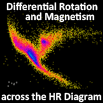Report for the programme
The goal of the program was to advance our understanding of the physical processes generating differential rotation in various types of stars, and the role that this effect plays for stellar magnetic activity and dynamos.
The four-week program was preluded by a conference which took place in a lecture room of KTH. A total of 76 participants (21 from 7 nordic institutions) joined the program by either coming for the conference or staying longer, during the other weeks which were filled by a total of 31 seminar lectures. The topics covered observational and statistical issues of measuring differential rotation and magnetic fields on stars as well as theoretical considerations and models on the generation of differential rotation and dynamo processes.
Observations of low- mass stars by high-precision photometry delivered numerous values for their differential rotation, especially from data of the Kepler mission (Basri, Reiners, Reinhold). Inverting one-dimensional light-curves into a multi-dimensional domain of individual spot rotations or even positions bears the problem of ambiguous solutions (Lehtinen, Arlt). Similarly, the reconstruction of stellar surfaces from spectroscopy (Kochukhov, Morin, Strassmeier) is a challenge where conversion of results has to be reached eventually. In a statistical way, however, the large number of stars reveals already the general dependencies of differential rotation on mass and rotation speed. A special discussion on how various stellar parameters are inferred from spectra was illuminating for the researchers in theory in particular. Once methods are established and being in use for years, one should always go back and look at the initial assumptions and ask whether they are still a good choice.
The advent on seismology on stars is a great step towards measuring the internal rotation of stars (Lund). The rotation periods of stellar cores in evolved stars are a particular example where the understanding of angular momentum is challenged, since much more transport is required than typically assumed in stellar evolution computations (Cantiello). This involves the understanding of instabilities in radiative zones of stars (Bonanno, Braithwaite, Busse, Kitchatinov).
On the theoretical side, two completely complementary methods deliver differential rotation profiles for stars. One is the Lambda-effect theory which predicts angular momentum transport coefficients from a mixing-length treatment of the rotating, stratified turbulence (Kitchatinov, Kleeorin, Küker) and obtains nearly perfect large-scale solutions for the differential rotation of the Sun. The method predicts the differential rotation of other stars, and it was a remarkable results discussed at the program that a large number of Kepler stars follow roughly the obtained trend with stellar mass. The other method is direct numerical simulations in high-resolution spherical domains aiming at capturing the transport effects of the turbulence directly. Direct simulations (Bessolaz, Browning, Brun) have shown nearly solar-like differential rotation, while the results for the meridional circulation (Miesch) still lack a clear observational confirmation. The influence of including part of the solar interior and exterior on the solutions has been discussed in the program (Warnecke).
The dynamo process in stars is another subtle process converting the energy of small-scale motions into large-scale magnetic fields. It was discussed to which extent we can detect stellar activity cycles from observations (Borisova, Garcia, Hackmann, Karoff, Kriskovics, Reiners) given their limited coverage in time. The presence of magnetic fields on a certain minority of massive stars is another puzzling topic (Kholtygin).
The large number of direct global numerical simulations all face the problem of not reaching the actual parameters set by the stars and the planets. The way of extrapolating the results to real objects has been disputed a lot, and the program helped a lot in understanding the strengths and weaknesses of direct simulations. Mean-field modelling using turbulence properties is an alternative that needs to be improved as well (Guerrero, Miesch, Rogachevskii, Schmitt, Sokoloff, Sood).
The fact that many objects with magnetic fields, but in no way all of them, seem to align with simulations on a function that relates magnetic field energy with convective heat flux indicates that these objects efficiently convert heat into magnetic energy in their convective layers (Duarte, Petitdemange, Schrinner, Yadav). Rotation and possibly other parameters will be modifiers in this conversion that renders many objects inefficient dynamos, such as the Sun. It has been argued that age and position in the HR diagram are related to the presence of cycles and the topology of the fields (Gregory, Schröder). The extremely detailed knowledge of solar activity (Arlt, Benevolenskaya, Illarionov, Kuzanyan, Zhang, Zolotova) is of course a main driver in getting the solar cycle (Karak) and the emergence of sunspots modelled correctly (Fournier, Jabbari, Rivero Losada).
The global simulations of a solar convection zone with an external conducting domain mimicking the corona as presented in the conference showed direct evidence for an equatorward migration of magnetic-field belts (Cole, Käpylä) and allows allowed for solar-like, i.e. not cylindrical, differential rotation in the convection zone (Brandenburg, Warnecke). The computations emphasize the influence of the boundaries on the turbulent processes and have been - among others - prominent nordic contributions to the programme.
Suggestions
The organisation of the program went very smooth and all technical details were handled by the Nordita staff very swiftly. The diversity of participants and requests showed, however, that improvements could be made to the options offered in the cms-system for the management of participants and expenses. If one allows for a larger number of people attending beyond the usual ~25 participants, options for marking external funding of people may be useful to keep track of the expenses.
An urgent request concerns the application form, especially the field "Accomodation". It suggests that selecting "Accomodation provided by Nordita" is free of charge and a matter of course. Several participants were irritated by the fact that either Nordita or themselves have to pay for the accomodation. We suggest to reformulate the accomodation part in a way that i) Nordita pays accomodation, ii) participants pay the reduced price offered to Nordita, or iii) care for their own accomodation.

